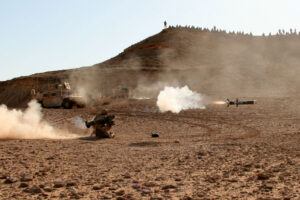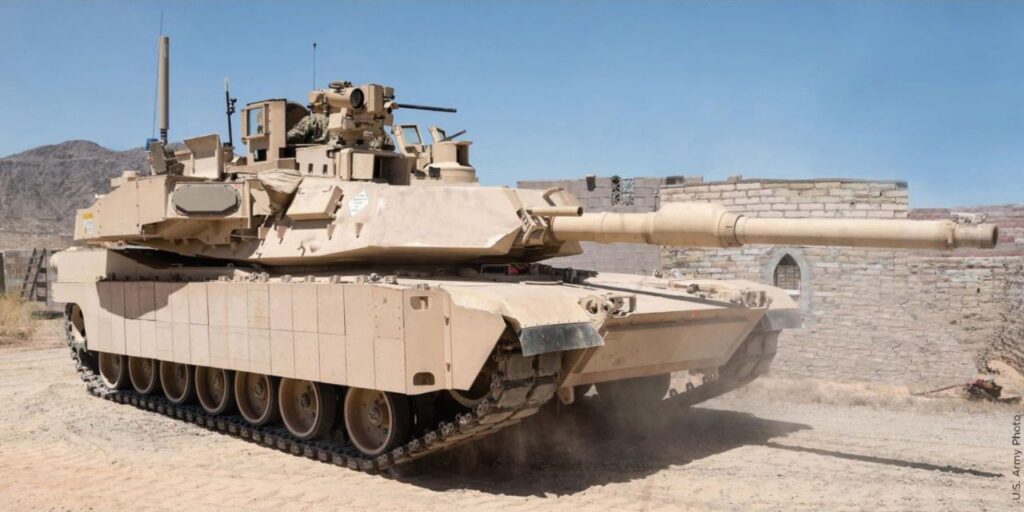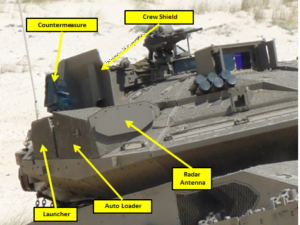Trophy APS: The Best Defense Is Shooting Back
Posted on
WASHINGTON: No, the Trophy anti-missile system now going on US tanks won’t accidentally shred friendly troops when it goes off, the manufacturer told me this morning. And, the expert from Rafael Ltd. explained, Trophy will calculate where the enemy fired at you from so you can shred them.
“APS, Active Protection System, is not an accurate term,” the Rafael exec and veteran Israeli tanker told me. “If you are only protecting yourself, the enemy will continue shooting at you.” That doesn’t mean they’ll hit you — US testers fired at a Trophy-equipped tank 48 times without a kill — but why give them the chance?
To intercept a threat, the Trophy system needs detailed data on its trajectory, which means it can figure out the point of origin. “The system will provide…the exact location of the shooter,” he said, and not just to you: The targeting data goes to “the other vehicles in the formation” over a radio network. That’s more than a nifty feature. It’s a minor tactical revolution.

A Marine fires a Javelin anti-tank missile.
Since 1916, the biggest threat to tanks has been, not other tanks, but ambush by hidden anti-tank weapons — from repurposed field guns in World War I to specialized panzerjäger vehicles in World War II to shoulder-fired rocket propelled grenades and anti-tank guided missiles today. Tank designers have improved armor materials to diffuse the impact of explosions and installed “reactive armor” that blows itself up to prematurely detonate incoming warheads. But without some sort of breakthrough, more advanced threats require heavier armor, driving modern Western main battle tanks like the American M1 Abrams and Israeli Merkava north of 70 tons.
The promise of Active Protection is that, without adding much weigh (by tank standards), they can defeat a lot of threats, albeit not all. There are two ways to get enough energy to kill a tank:
- kinetic energy, a solid armor-penetrating slug at staggering velocity, which requires a big main gun that will only fit on another tank; or
- chemical energy, i.e. an explosive warhead, which is what everybody but tanks has to use.
Current APS technology can’t stop the solid tank rounds, but it can stop the lower-velocity explosive rounds used by enemy infantry and aircraft — traditional ambushers of tanks. An APS that pinpoints the shooter for immediate retaliation, potentially by the whole tank unit, could turn the tables even further by stripping away the defining advantage of the ambush, concealment.

Army M1 Abrams tank with a trial installation of the Israeli-made Trophy Active Protection System (APS)
How Trophy Works
So how does Trophy work? In essence, an APS is a miniaturized missile defense system that goes on an armored vehicle. It requires multiple radars — carefully sited around the tank for clear lines of sight — to spot incoming threats from all directions. Then it needs a powerful computer to make sense of the data in a fraction of a second: You don’t want your APS going off every time something fires a bullet or when a bird lands on the turret. Only if the computer decides there is a real threat does it send warning data to the crew and nearby vehicles.
What’s more, only if the computer decides there is a real threat and it’s probably going to hit does it engage the “hard kill” countermeasure to shoot it down. Ironically, Trophy fires a miniaturized version of the Explosively Formed Projectiles (EFPs) that have destroyed so many US and Israeli vehicles in the last decade. An EFP is created in an explosive process — as the name says — but isn’t an explosive itself.
Critics have liked Trophy to “a shotgun blast. It’s not,” the Rafael official insisted. “It’s a sniper shot…. a small number of EFPs in a very small area, aimed at a specific point on the warhead itself.” Rather than just blow the threat out of the air, Trophy tries to disable the threat so it doesn’t detonate.

Trophy Active Protection System components
That doesn’t always work: Some test videos online show incoming rounds going off in spectacular fireballs that mean at least some of the explosive material went off. But even if that happens, Rafael insist, there’s less than a 1 percent risk that nearby troops or civilians will be harmed. While Israeli standard procedures call for infantry to keep well away from armored vehicles so they aren’t run over, he said, in combat infantry often take cover behind a tank, and that tactic hasn’t changed because those tanks have Trophy. In fact, he said, there are documented cases of Trophy intercepting an incoming missile while the tank commander had his head out of the hatch to look around, or in one case while he was actually getting out, and none of those crewmembers has been injured.
The Israelis currently use Trophy on two models of their Merkava main battle tank, as well as on the heavily armored Namer troop carrier. But Rafael has tested it on much lighter armored vehicles, including the US Army’s 8×8 Stryker in 2006 and 2010, the official said.
In the current crash program, the US Army is only installing Trophy on the M1 Abrams heavy tank, while it’s trying rival systems on the lightweight Stryker and middleweight M2 Bradley. It would be more challenging in install Trophy on those smaller vehicles, the official acknowledged, but it would be possible.
Having Trophy on all three vehicles would be a lot logistically simpler than having three different systems, the Rafael official pointed out. Because they’re still R&D efforts, he argued, Trophy’s rivals also lack its real-world track record and its established supply chain.
Much of that supply chain for Trophy is in the US. “We could produce it locally in the US, because we are manufacturing today more than 50 percent of the system in the US,” the Israeli exec said, before adding a very American comment: Trophy has suppliers in 15 states.
Corrected 2:55 pm. The original version of this article misstated the number of states in which Trophy had suppliers.
Subscribe to our newsletter
Promotions, new products and sales. Directly to your inbox.
